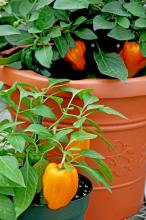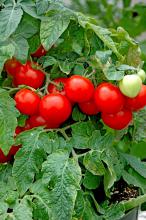Information Possibly Outdated
The information presented on this page was originally released on July 26, 2007. It may not be outdated, but please search our site for more current information. If you plan to quote or reference this information in a publication, please check with the Extension specialist or author before proceeding.
Fall vegetables are mighty tasty
By Norman Winter
MSU Horticulturist
Central Mississippi Research & Extension Center
Most gardeners think spring is the best time for gardening, but if you haven't tried a fall garden, consider putting one in now. These can be the best gardens all year.
Every October, thousands of visitors come to our Fall Flower and Garden Fest to see what a terrific fall garden is like. I can tell you the produce is mighty tasty because it ripens in a cooler, less stressful time of the season. It suffers less from sunburn or sunscald, and fall has fewer insects and diseases.
To determine when you should plant, count backward from the first annual freeze. For the sake of example, let's say Nov. 1 is the typical first freeze.
How many days are there from planting the seed until first harvest? Let's presume something like 60 days. Do you expect your plant to produce for maybe 30 to 60 days?
You can see late July to early August is planting time for crops that can take no frost. Crops like broccoli, cauliflower, lettuce and spinach can be planted a little later.
Cutting back or carrying tomatoes through summer for fall production is a source of many an argument. Spring-planted tomatoes can be cut back for renewed fall production only if the plants are healthy and free of insect problems. Trying to carry an unhealthy plant through the summer usually means disaster.
I prefer planting young tomato transplants now. If you decide to cut the tomatoes back, avoid removing too much foliage since hot weather can burn the plants to death. After pruning, apply additional fertilizer and water to renew growth and increase tomato production well into fall. I promise you will be a star when you serve homegrown, ripened tomatoes for Christmas.
Similar questions are asked about fall-grown okra. Okra can be cut back, but it might be better to make a midsummer planting instead. When pruned, the plants develop a bush rather than a single stalk, and this usually makes harvest difficult. If you prune, do so 80 to 100 days before the first anticipated fall frost. This allows the plants time to produce additional pods.
One problem many gardeners face is getting the seed to come up when planted during the heat of the summer. This is especially true for cold-hardy vegetables like broccoli, carrots or lettuce that germinate poorly when the soil temperature is high.
To help seeds germinate, prepare a bed or ridge for planting. Mark off rows and use a hoe handle or stick to make a seed furrow usually about 1 inch deep. Water the loosened soil in the seed furrow to a depth of 4 to 6 inches. After the water has soaked in, scatter the seeds evenly along the furrow.
Instead of garden soil, cover the seeds with a material such as compost, potting soil or peat moss. This provides a better environment for seed germination and prevents soil crusting.
After the seeds emerge, consider using something like cardboard or an old roofing shingle placed on the west side of the row to shade the plants from the intense afternoon heat. This is also a good idea for tomato, pepper or cole-crop transplants.
If you are like me, the back and knees get tired bending down to plant seeds. An easy way to place seeds right where you want them is by using a PVC pipe. Cut about 4 feet long, this becomes a handy tool as you simply drop the seeds through the pipe to your desired location.
Another option is to grow vegetables in containers. Over the last decade, there have been some great new varieties of tomatoes, peppers and eggplants that are perfect for growing on the patio. The tomato variety Totem was made for the patio garden.
The containers don't need to be large or extravagant to harvest a bounty of produce. My main rule is to select a good, light potting mix that drains well. Of course, it is a no-brainer to make sure the container has drainage holes.
Even though it is hot now, try fall gardening. When you harvest, the temperature will be cool and the produce will be tasty.




